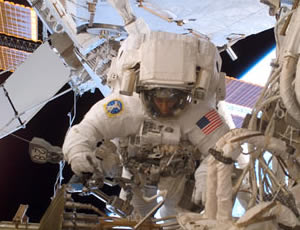
 |
|
|
Space station astronauts on third spacewalkFebruary 8th, 2007Cape Canaveral, Florida - International Space Station Commander Mike Lopez-Alegria and Flight Engineer Sunita Williams began the third of series of spacewalks Thursday from the Quest airlock. 
Lopez-Alegria and Williams completed the first two in the three-spacewalk series from Quest over the nine-day period on Jan. 31 and Feb. 4. The focus of the first and second spacewalks was on reconfiguration of station power and cooling systems to permanent ones. Major tasks of this spacewalk include removing and jettisoning two large shrouds and installation of attachments for cargo carriers. Lopez-Alegria and Williams will move from the airlock out to Crew Equipment Transfer Aid (CETA) carts on the rails of the main truss. Pushing the cart with their equipment, including a foot restraint, they move to the Port 3 truss segment. Their first job is to remove two thermal shrouds on two Rotary Joint Motor Controllers (RJMCs) on P3. Next they will remove the two large shrouds, from P3 Bays 18 and 20. The shrouds, larger than king-size bed sheets, provide thermal shading. With the station in its present orientation, they are no longer needed. They are being removed to avoid trapping heat. Spacewalkers will work together to fold each into a package a bit smaller than an outdoor garbage can and jettison them, aft and slightly downward. That 2-hour, 40-minute shroud task will be followed by deployment of an Unpressurized Cargo Carrier Assembly Attachment System (UCCAS) on the upper face of the P3 truss. The hour-long job is in preparation for attachment of a cargo carrier during a subsequent shuttle mission. While Lopez-Alegria finishes work on the second UCCAS, Williams will move out to the end of the P5 truss to remove two launch locks to prepare for the relocation of the P6 Truss. The final scheduled task of the spacewalk is connecting four cables of the Shuttle-to-Station Power Transfer System (SSPTS) to Pressurized Mating Adapter-2 (PMA-2) at the forward end of the Destiny laboratory. The SSPTS will allow visiting shuttles to take power from the station and thus extend their missions. Work began on the system during the Jan. 31 spacewalk, and two of the cables were routed and connected to PMA-2 during the Feb. 4 spacewalk. The last four cables are to be connected today. Get ahead tasks include routing and connecting a Node LAN cable. The cable will give crew members the capability of commanding Russian systems from the station's U.S. Segment. Also, if time permits, the crew will move a Node tool stanchion to a CETA cart and retrieve a foot restraint to return it to the airlock. They also may remove a Node handrail. The three spacewalks from the Quest airlock in U.S. spacesuits and a Russian spacewalk scheduled for Feb. 22 are the most ever done by station crew members during a single month. They also will bring to 10 the total number of spacewalks by Lopez-Alegria, an astronaut record. Williams will have a total of four, the most ever by a woman. Starting from scratch, it takes about 100 crew-member hours to prepare for a spacewalk. By doing them a few days apart, considerable crew time can be saved by not having to repeat some of those preparatory steps. On Feb. 22, Lopez-Alegria and Tyurin are scheduled to do the Russian spacewalk in Russian Orlan suits from the Pirs airlock. They will work on an antenna of the Progress 23 unpiloted cargo carrier, docked at the aft port of the Zvezda service module. The antenna did not properly retract when that spacecraft docked in October. The spacewalkers will try to secure or remove the antenna to avoid its interfering with the undocking of P23 in April. © AlaskaReport News |
|